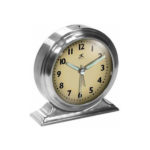 The Passage of Time
The Passage of Time
I’ve always had an uneasy relationship with time. When I was young, there never seemed to be enough of it. Each year when I was required to select one or two electives from a list of about twenty I anguished over my choices. Couldn’t I take three? Perhaps four? Surely I could handle five?
But Friday nights were different. I wasn’t allowed to date or even go out with my friends until I was sixteen, but as the weekend rolled around, I was sure my friends were all out somewhere, doing it something interesting, while I had to stay home alone. Consequently, Friday nights dragged on forever. Once I passed the magic age of 16, I worked very hard to make sure I never stayed home on a Friday night. When I began working, it seemed like there were never enough hours in the day to accomplish all the tasks I had been asked to do, and Friday nights became catch-up night instead of party night.
And when I was a single mom with four children? We won’t even go there.
Once I retired, I went from not having enough time in a day to having too much time on my hands. I’ve written about that dilemma and what I did about it here.
Now, in the midst of a summer entirely given over to writing, I am grateful for the time I have carved out for myself, but I’m also, just once in a while, looking forward to the long evenings in winter when I will wrap myself in a warm blanket and curl up with a book.
Telling Time
Do you remember learning how to tell time? It just seemed to happen naturally for me. We had a clock in the kitchen, and Dad had an alarm clock by his bed. Somehow, by the time I was in school, I knew how to read these clocks well enough to leave for school on time each morning and get myself into bed by the designated bedtime. I soon also learned when it was time for Micky Mouse Club and Lassie to come on TV.
So when I began taking care of my granddaughter, I furnished her playroom 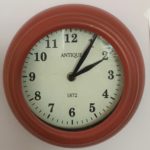 with a clock just like the one I grew up with: a bright colored plastic circle with large numbers from 1 to 12, and two hands clicking around the face. I had another one in my kitchen. Over the first six years of her life I made frequent reference to them.
with a clock just like the one I grew up with: a bright colored plastic circle with large numbers from 1 to 12, and two hands clicking around the face. I had another one in my kitchen. Over the first six years of her life I made frequent reference to them.
Imagine my surprise, then, when one Thursday, my day to help with math activities in Bean’s first grade class, we turned to Lesson 20 of the Common Core Coach Mathematics 1 workbook and I saw this:
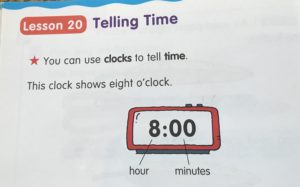
To be fair, the workbook also showed this:
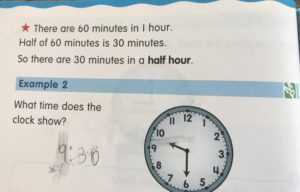 But the entire lesson, the only time during first grade that time would be taught formally, consisted of seven pages of lessons and places where Bean was asked to fill in the blanks. Working through the assignment that night, she said it was “hard” and “boring” and she made many erasures.
But the entire lesson, the only time during first grade that time would be taught formally, consisted of seven pages of lessons and places where Bean was asked to fill in the blanks. Working through the assignment that night, she said it was “hard” and “boring” and she made many erasures.
We talked about time for a while, and why it mattered, and she pointed out to me, quite logically, that in her house the clocks all had digital displays, and that in any case, Mommy got her where she needed to go, so why did she need to know what time it was? Without the motivation to learn to read an “old fashioned” clock, I could see that it would it be frustrating to figure out why it’s thirty minutes after the hour when the big hand is on the six. Shouldn’t that be six minutes after the hour?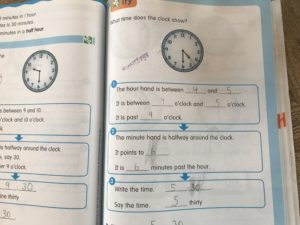
Children of 2018 don’t need to know the time in order to watch a particular television show at a particular time — they can watch Daniel Tiger or the Aquanauts on demand. And most youngsters don’t walk to school, or anywhere else for that matter, so they don’t need to know what time to leave the house or what time to come home.
Managing Time
But telling time is about more than translating the face of a clock, digital or analog. It’s also understanding how long it takes to walk or drive a particular distance, prepare a meal, read a chapter in a book. My border collie, Kismet, can’t read a clock, but she knows exactly when it’s time for dinner. She arrives at my side, looks up at me with those big brown eyes, and shoves her nose under my arm repeatedly. An hour later she is standing at the door, waiting for me to get the leash and take her out for a walk.
I discovered that if I talked about time as Bean and I we went about our daily activities, she began to participate in the conversation. For example, on the way home she asked if we could stop at her favorite strawberry stand to get some strawberry juice and a basket of strawberries to take home. “Ok,” I would say, that will take us about half an hour. That leaves an hour before it’s time for Tai Kwon Do. But it takes us half an hour to get there. How much time does that leave for washing up and changing into your uniform?”
Repeated conversations like that over time can lead into thinking about time in meaningful ways. For example, “If you want your painting project to dry before Mom comes to pick you up at 5:00, what time should we hang it up to dry?” Fortunately, the Common Core curriculum presents telling time in this more complex way later on, in third grade, when children have a more secure grasp of logical thinking
But knowing how to read an analog clock is still useful, since they still exist in places like train stations and classroom walls. Once a child learns how to count by fives, that concept can be transferred to a clock with hands. To help Bean see that, I took a paper plate and made a dual-number clock, with 1-2-3-4-5 and also 5-10-15-20-25 around the outside. I affixed moveable hands to the clock with a brass fastener. Bean and I took turns setting the clock for various times and counting by fives to figure out the time.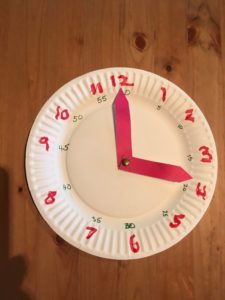
Bean may have less motivation to learn to tell time than I did, but she lives in a world where time matters, both the actual time of day and also the passage of time.
I think it’s important to help children master both of those elements.
What is your experience with teaching children to tell time? Have you switched over to only digital clocks in your home, or do you still have clocks with hands like me? Do children still need to learn to tell time the old fashioned way, or am I acting like a dinasaur?
I’d love to know what you think.
If you would like my posts to arrive in your email box whenever they are published, please subscribe to this blog.
See you next time! Marlene
Share this post

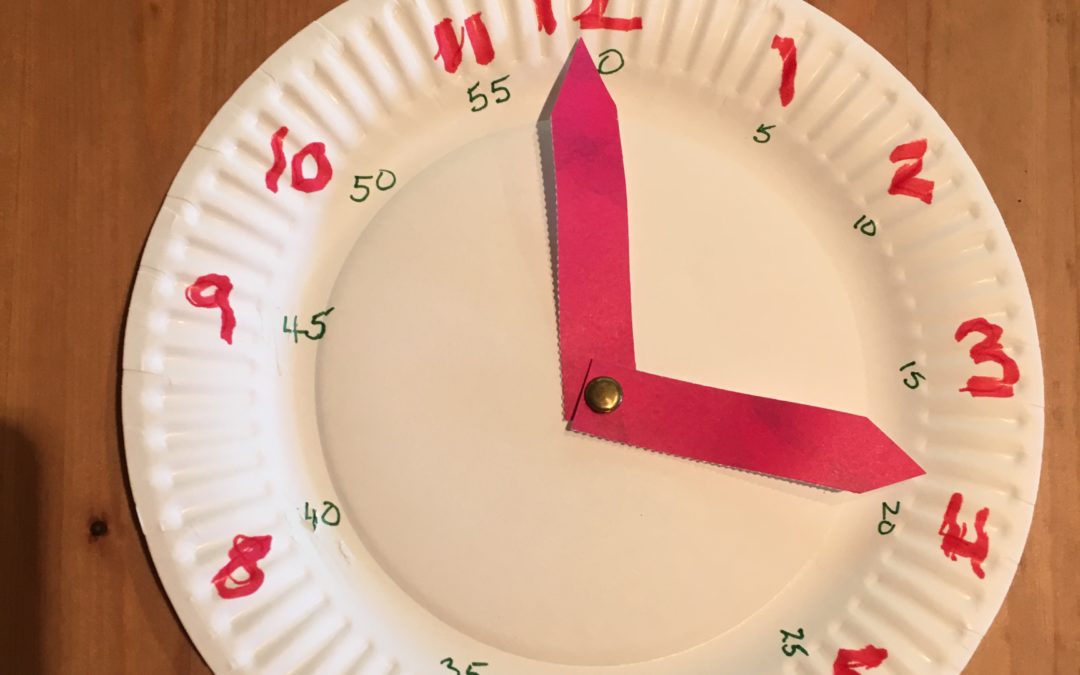



Hi, I think one of the most helpful things for children learning about time is to be able to use the clock face to anticipate when they will be able to have their turn, when their friend will be coming over at the agreed upon time, when they will be able to go back in the swimming pool after lunch and any number of other reasons.
Young children especially have difficulties with yesterday, today, and tomorrow and with all those special events that happen within each day. Digital clocks just do not help teach that because the digital clock just clicks to the next without allowing for comparisons as the face of the clock does. Making clock faces that allow children to manipulate time, looking at now and when something important will happen, or even in Bean’s case, for homework questions, gives some control over beginning to understand time passing and predicting when something will happen. So much of what happens in children’s lives is out of their control that giving them the chance to decide what to fit in-between now and a much looked forward to event gives them chances to plan, organize, make choices, prioritize. Barbara
Barbara,
Your observations about the practical use of telling time are wonderful. Thanks so much for sharing your experience and your insight.
You’re absolutely not a dinosaur, Marlene! (Or, if you are—I am, too! Because I believe the old fashioned way of telling time is a super important skill, as well. 😉
Your post made me think of a fabulous episode of This American Life, called “It’ll Make Sense When You’re Older”—I’m linking to it here for you to take a listen: https://www.thisamericanlife.org/583/transcript
Even if you can’t listen to the entire thing, fast-forward to Act Four: Old Age, for a very interesting and touching story about dementia and clock-reading. I suspect you’ll love it.
As always, it’s a pleasure reading what you write here.
What a wonderful story on This American Life, Helen. Thanks so much for sharing!
Hi Marlene, this post is especially timely for me since we will be having a visit from our youngest grandson in August. When I found out that he can’t tell time from an analog clock I was amazed. His twin sister and his older brother have no trouble with it. I found a video about telling time that I am planning to use with him while he is here and your posts give me some ideas for patter to go along with it during his visit. And some inspiration!
That’s great, Linda. Glad to help. Stella tells me she still “loves” my rather rough paper plate clock, and uses it to figure out what time it is when she’s in her room reading.